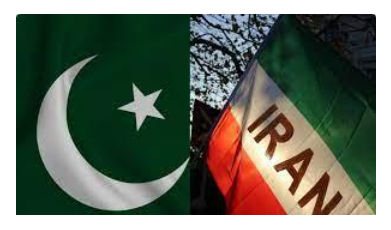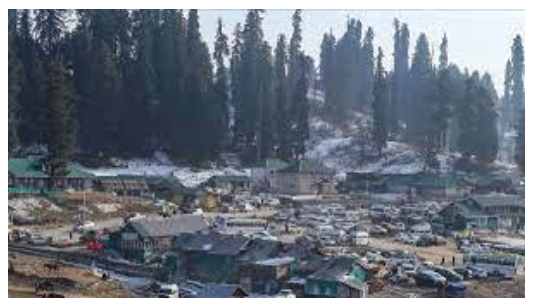Monday, 22nd January 2024
Draft Roadmaps Released by IT Ministry for Key Technology Sectors
In News: Draft Roadmaps Released by IT Ministry for Key Technology Sectors
Ministry of Electronics and Information Technology's Initiatives
The Ministry of Electronics and Information Technology has released draft roadmaps aimed at advancing indigenous research and development in crucial technology sectors. These roadmaps, developed by the Centre for Development of Advanced Computing, outline strategic plans to address various challenges within specific timeframes, extending from the present to 2047.
- Cybersecurity Roadmap
- Targets for 2026 include the development of "Social Media Analytics."
- "Dark Web Forensics" is set for completion by 2030.
- Ongoing efforts for the detection of child exploitation and human trafficking, beginning in 2027 and extending beyond 2047.
- Completion deadlines for GPS and vehicle forensics set at 2027 and 2029, respectively.
- Banking fraud and UPI payment forensics solutions targeted for completion by 2029 and 2030.
- Quantum Computing Roadmap
- Research and development efforts in quantum computing to continue until 2034.
- Mobile Security Roadmap
- Focuses on fostering "enterprise-grade" security systems.
- Centre for Development of Advanced Computing (C-DAC)
- Premier R&D organization of the Ministry of Electronics and Information Technology.
- Established in 1988 to address the denial of import of Supercomputers by the USA.
- Notable project: PARAM 8000, India's first supercomputer (1991).
- PARAM 8000 - India's First Supercomputer
- Built from scratch in 1991, utilizing components from the domestic market.
- Applications include long-range weather forecasting, remote sensing, drug design, and molecular modeling.
Understanding Technology Concepts
- Internet of Things (IoT)?
- Refers to the interconnected network of devices facilitating communication between devices and the cloud.
- Big Data?
- Primarily denotes datasets too large or complex for traditional data-processing applications.
Source: TH
Forest Fires in the Himalayas
In News: This winter, the Himalayan Region, particularly in Himachal and Uttarakhand, has experienced numerous forest fires, primarily attributed to a deficiency in precipitation.
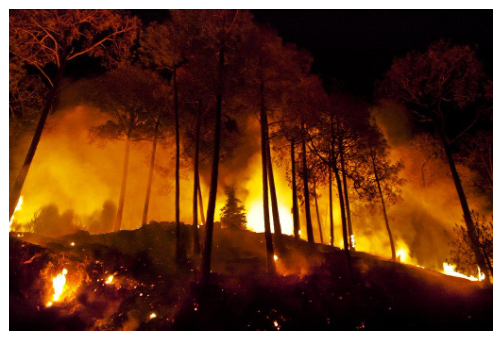
Understanding Forest Fires
- Definition
- A forest fire, also known as a bush or vegetation fire, refers to uncontrolled and non-prescribed combustion of plants in natural settings like forests, grasslands, brush lands, or tundra.
- It consumes natural fuels and spreads based on environmental conditions such as wind and topography.
- Conditions for Wildfires
- Three essential conditions must be present for a wildfire to occur: Fuel, Oxygen, and a Heat source.
Classification of Forest Fires
- Surface Fire
- Primarily spreads along the ground, engulfing surface litter on the forest floor.
- Underground Fire
- Low-intensity fires that consume organic matter beneath the forest floor.
- Spreads entirely underground, challenging to detect and control.
- Can persist for months, leading to soil and vegetative cover destruction.
- Ground Fire
- Fires in subsurface organic fuels, burning beneath the surface.
- No clear distinction between underground and ground fires.
- More damaging than surface fires, capable of destroying vegetation completely.
Factors Contributing to Himalayan Region Forest Fires
- Lack of Snowfall and Precipitation
- Winter months' absence of snowfall and rainfall leaves the region dry.
- Snowfall and precipitation are critical for maintaining soil moisture.
- Dry Conditions
- Lack of moisture in soil and vegetation creates favorable conditions for fires.
- Dry leaves and soil act as potential fuel.
- Human Activities
- Careless activities like discarding cigarettes or uncontrolled burning can trigger fires.
- Controlled burning by the forest department may contribute if not properly managed.
- Vulnerable Tree Species
- Presence of fire-prone and flammable species like Chir pine increases the fire risk.
- About 15% of Himachal's forest area is covered with chir pine.
- Long Dry Spell
- Extended periods without rainfall or snowfall create a susceptibility to fires.
Government Initiatives to Address Forest Fires
- National Action Plan for Forest Fires (NAPFF)
- Initiated in 2018 to reduce forest fires by informing and empowering forest fringe communities.
- Forest Fire Prevention and Management Scheme (FPM)
- Government-sponsored program dedicated to assisting states in dealing with forest fires.
Strategies for the Future
- Advanced Fire Detection and Monitoring
- Implement advanced systems, including satellite-based technologies, for early warnings and rapid response.
- Community Engagement
- Involve local communities in forest management and prevention efforts.
- Conduct awareness programs on responsible forest practices and fire safety.
- Sustainable Forest Management
- Implement practices focusing on biodiversity, promoting fire-resistant vegetation, and reducing flammable tree species.
|
UPSC Previous Year Questions Prelims (2019) Q. Consider the following:
Which of the above are released into atmosphere due to the burning of crop/biomass residue? (a) 1 and 2 only Ans: (d)
Mains (2014) Q. Most of the unusual climatic happenings are explained as an outcome of the El-Nino effect. Do you agree? |
Source: DTE
Multiple Sclerosis - Edukemy Current Affairs
In News: DNA extracted from the bones and teeth of ancient Europeans, dating back up to 34,000 years, sheds light on the origins of Multiple Sclerosis.

Key Findings
- Genetic Analysis of Ancient and Modern DNA
- Ancient genomes were analyzed and compared with modern DNA from the UK Biobank.
- The dataset included approximately 410,000 self-identified "white-British" individuals and over 24,000 born outside the United Kingdom.
- Significant Discovery Regarding Multiple Sclerosis
- Multiple Sclerosis (MS), a chronic autoimmune disease affecting the central nervous system, showed a noteworthy connection.
- A pivotal migration event 5,000 years ago during the Bronze Age brought the Yamnaya people, livestock herders from modern Ukraine and southern Russia, into Western Europe.
- Genetic traits initially beneficial for protection against infections from livestock became a risk factor for MS as sanitary conditions improved over time.
Understanding Multiple Sclerosis
- Overview
- MS is a chronic autoimmune disease where the body mistakenly attacks its own central nervous system (CNS).
- Symptoms
- Muscle weakness, numbness, difficulty emptying the bladder, frequent or sudden urination, bowel problems, fatigue, dizziness, and damaged nerve fibers in the spinal cord.
- Challenges in Diagnosis
- Early recognition is challenging due to common symptoms, leading to delayed diagnosis.
- No specific cause or trigger can be determined.
- Possible Causes
- Unknown exact cause; likely a combination of genetic factors passed down in genes, smoking, stress, and deficiencies in vitamins D and B12.
Understanding Deoxyribonucleic Acid (DNA)
- Molecular Structure
- DNA is an organic molecule with a complex molecular structure.
- Composed of long chains of monomer nucleotides, forming a double helix structure.
- Discovery by Watson and Crick
- James Watson and Francis Crick discovered the double-helix polymer nature of DNA in 1953.
- Genetic Transfer
- DNA is crucial for transferring genetic characteristics from one generation to another.
- Cellular Location
- The majority of DNA is located in the cell nucleus, termed nuclear DNA.
|
UPSC Previous Year Questions Prelims (2016) Q. Consider the following statements:
Which of the statements given above is/are correct? (a) 1 only Ans: (d) Exp:
Therefore, option (d) is the correct answer. |
Source: TH
Classical Language Status for Bangla, National Recognition for GangaSagar Mela
In News: West Bengal's Chief Minister gained attention for championing classical language status for Bangla, the 7th most spoken language globally, and pushing for national fair recognition for Gangasagar Mela.
Understanding Gangasagar Mela
- Overview
- Gangasagar Mela, occurring during Makar Sankrati (mid-January), ranks as India's second-largest pilgrimage after the Kumbh Mela.
- Attracts millions to Sagar Island, marking the confluence of the Ganges and Bay of Bengal.
- Commemorates King Bhagirath's legendary descent of the Ganges to Earth.
- Benefits of National Status
- National recognition could bring increased central funding, infrastructure development, and economic growth in West Bengal.
- Comparison with Other Major Melas
- Kumbh Mela: Celebrated four times every 12 years, rotating between four sacred rivers.
- Ardha Kumbh Mela: Held every sixth year in Haridwar and Allahabad.
- Maha Kumbh Mela: Organized after every 144 years.
- Pushkar Mela: Annual five-day camel and livestock fair in Pushkar, Rajasthan.
- Hemis Gompa Fair: Celebrated in Ladakh, commemorating Guru Padmasambhava's birth anniversary.
Classical Languages in India
- Overview
- New category introduced in 2004, known as "classical languages."
- Criteria for Classification
- High antiquity of early texts/recorded history spanning 1,500–2,000 years.
- Possession of ancient literature considered valuable heritage.
- Presence of an original literary tradition distinct from modern forms.
- Discontinuity between classical language and its later forms.
- Benefits of Classical Language Status
- Financial assistance for setting up a center of excellence.
- Eligibility for major awards for eminent scholars.
- Possibility of creating professional chairs in central universities.
- Criteria designed to preserve and promote valuable linguistic heritage.
Note on Constitutional Languages
- The 8th Schedule of the Indian Constitution lists 22 official languages, including Assamese, Bengali, Hindi, Sanskrit, and others.
|
UPSC Previous Year Questions Prelims (2015) Q. Which one of the following was given classical language status recently? (a) Odia Ans: (a) Prelims (2008) Q. Under which one of the following Constitution Amendment Acts, four languages were added to the languages under the Eighth Schedule of the Constitution of India, thereby raising their number to 22? (a) Constitution (Ninetieth Amendment) Act Ans: (c) |
Source: TH
Aravalli Range
In News: In a recent statement, the Supreme Court expressed that if the State of Rajasthan is of the view that mining operations in the Aravalli Range pose an environmental threat, it has the authority to prohibit such mining activities.
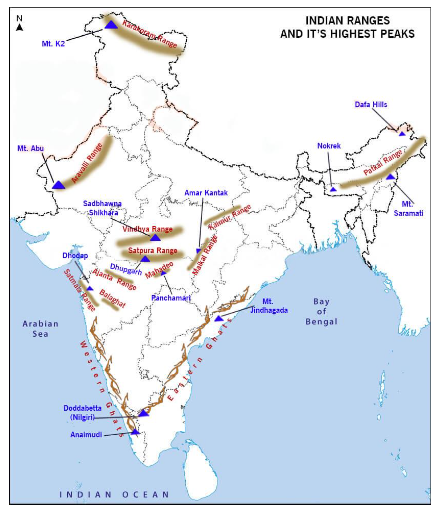
About Aravalli Range
- Location and Extent
- The Aravalli Range is situated in northwestern India.
- It spans approximately 670 km (430 mi) in a south-west direction, commencing near Delhi, passing through southern Haryana and Rajasthan, and concluding in Gujarat.
- Characteristics
- Among the world's oldest fold mountains, the Aravalli Range is marked by a series of ridges and peaks.
- Widths vary from 6 to 60 miles, with elevations ranging between 1,000 and 3,000 feet.
- Guru Shikhar, at 5,650 feet on Mount Arbuda, stands as the highest point.
- Geological Formation
- Formed during the Proterozoic era as part of the Aravalli-Delhi orogenic belt, a result of tectonic plate collisions.
- Once towering, millions of years of weathering have worn down the Aravalli.
- Rivers and Role
- Three major rivers and their tributaries originate from the Aravalli, including the Banas and Sahibi rivers (Yamuna tributaries) and the Luni River (flows into the Rann of Kutch).
- Serves as a natural barrier separating the Thar desert from the plains and plateaus of eastern Rajasthan.
- Mineral Resources
- Rich in mineral deposits like copper, zinc, lead, and marble.
- Sections and Peaks
- Divided into two sections: Sambhar-Sirohi ranges (including Guru Shikhar) and Sambhar-Khetri ranges (with three discontinuous ridges).
- Wildlife and Conservation
- Encompasses several national parks and wildlife sanctuaries, such as Sariska National Park, Kumbhalgarh Sanctuary, and Mount Abu Sanctuary.
Source: LL
Kanger Valley National Park
In News: Kanger Valley National Park is spearheading a novel collaboration with organizations and government departments for an innovative ecological restoration plan.
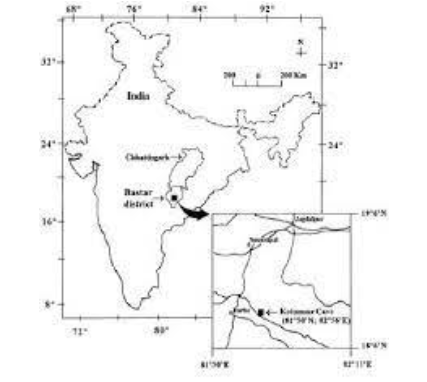 About Kanger Valley National Park
About Kanger Valley National Park
- Location
- Situated in Jagdalpur, Bastar district, Chhattisgarh, Kanger Valley National Park is positioned along the Kholaba River, a tributary of the Godavari.
- Establishment
- Attained national park status in 1982.
- Spans an area of 200 square kilometers with an average width of 6 km (north to south) and length of 34 km (west to east).
- Entire park designated as a core area, without a buffer zone.
- Topography
- Known for diverse land formations, including low, flat areas, gentle slopes, steep inclines, plateaus, valleys, and stream courses.
- Features three remarkable caves – Kutumbasar, Kailash, and Dandak – renowned for unique geological structures.
- Geological Wonders
- Home to underground limestone caves with formations of stalagmites and stalactites.
- Tirathgarh Waterfall is a prominent attraction within the park.
- Flora
- Exhibits a mixed humid deciduous forest type, abundant in Sal, Saugaun, teak, and bamboo trees.
- Fauna
- Diverse wildlife includes tigers, mouse deer, leopards, wildcats, sambar, chital, barking deer, langurs, jackals, rhesus macaques, and flying squirrels.
- Aerial fauna comprises common hill myna, red jungle fowl, spotted owlet, racket-tailed drongos, parrots, and more.
- Human Presence
- Hosts a significant tribal population.
- Natural Attractions
- Features the ongoing growth of stalagmites and stalactites in the limestone caves, adding to the park's geological allure.
Source: TOI
lamprey fish
In News: A recent research study has identified two potential new species of lamprey fish in the waters of California.

About lamprey fish
- Overview
- Lampreys are ancient, jawless fish with eel-like bodies, existing for over 350 million years.
- Belonging to the primitive group of jawless fish called Agnathans, they are boneless.
- Habitat
- Found in coastal and fresh waters, lampreys inhabit temperate regions worldwide, excluding Africa.
- Physical Features
- Vary in size from 15 to 100 centimeters (6 to 40 inches).
- Lack scales, fins, and gill covers, resembling eels.
- Breathe through seven pairs of tiny gill openings behind mouths and eyes.
- Skeletons made of cartilage, similar to sharks.
- Distinctive Mouth
- Jawless, circular, fleshy sucker serves as the mouth.
- Filled with hundreds of small teeth and a rasping tongue.
- Migratory Behavior
- Migrate between fresh and saltwater for their lifecycle.
- Spend most of their lives at sea, entering freshwater for spawning and the juvenile life stage.
- Parasitic Feeding
- Attach themselves to large animals, such as fish and whales, using their sucker mouths.
- Feed as parasites by rasping into the host's flesh with sharp teeth and extracting blood.
Source: PO
Pradhan Mantri Awas Yojana – Urban (PMAY-Urban) Scheme
In News: During an event dedicating homes constructed under the Pradhan Mantri Awas Yojana – Urban (PMAY-Urban) Scheme, the Prime Minister emotionally addressed the crowd, shedding tears.
About Pradhan Mantri Awas Yojana – Urban (PMAY-Urban) Scheme
- Overview
- Pradhan Mantri Awas Yojana – Urban (PMAY-U) has been in implementation since June 2015, serving as a flagship program under the Ministry of Housing and Urban Affairs (MoHUA) in India.
- Objective
- Aimed at providing all-weather pucca houses to eligible beneficiaries in urban areas by 2022, implemented through States/UTs/Central Nodal Agencies.
- Coverage
- Encompasses the entire urban area of the country, including statutory towns as per Census 2011 and subsequently notified towns, including Notified Planning/Development Areas.
- Implementation Verticals
- Implemented through four verticals:
- Beneficiary Led Construction/ Enhancement (BLC)
- Affordable Housing in Partnership (AHP)
- In-situ Slum Redevelopment (ISSR)
- Credit Linked Subsidy Scheme (CLSS)
- Continuation and Funding
- In August 2022, the Union Cabinet approved the extension of PMAY-U until December 31, 2024, excluding CLSS.
- Credit linked subsidy component as a Central Sector Scheme, while other three components as Centrally Sponsored Scheme (CSS).
- Basic Amenities
- All houses include essential amenities like toilets, water supply, electricity, and kitchens.
- Women Empowerment
- Promotes women empowerment by facilitating house ownership in the name of a female member or in joint names.
- Inclusive Approach
- Provides preference to differently-abled persons, senior citizens, SCs, STs, OBCs, Minority groups, single women, transgender individuals, and other weaker and vulnerable sections of society.
- Cafeteria Approach
- Adopts a cafeteria approach, tailoring solutions based on geographical conditions, topography, economic factors, land availability, and infrastructure.
Source: ABP
Global Alliance for Global Good - Gender Equity and Equality
In News: India has effectively launched the "Global Alliance for Global Good - Gender Equity and Equality" with the aim of fostering women's empowerment and gender equality.
- Introduction of Global Alliance
- India launched the "Global Alliance for Global Good - Gender Equity and Equality" during the 54th annual World Economic Forum (WEF) meeting in Davos.
- Objectives
- Aims to consolidate global best practices, facilitate knowledge sharing, and provide investment opportunities in women's education, health, and enterprise.
- Alignment with SDGs
- Advances multiple Sustainable Development Goals (SDGs), including SDG 3 (Good Health and Well-Being), 4 (Quality Education), 5 (Gender Equality and Empowerment), and 17 (Global Partnership for Development).
- Industry Support
- Gains endorsement from industry leaders such as MasterCard, Uber, Tata, TVS, Bayer, Godrej, the Serum Institute of India, IMD Laussane, and over 10,000 partners through the Confederation of Indian Industry (CII).
- Foundation Backing
- Supported by the Bill and Melinda Gates Foundation.
- Housed and anchored by the CII Centre for Women Leadership.
- Partnerships
- Secures the World Economic Forum (WEF) as a ‘Network Partner’ and Invest India as an ‘Institutional Partner.’
- Key Facts about WEF
- International organization headquartered in Geneva, Switzerland, addressing global economic, political, social, and environmental issues.
- Renowned for its annual meeting in Davos, attracting global leaders for discussions.
- Influences decisions by introducing new issues and trends.
- Funded through memberships, featuring prominent business and political figures.
Source: MC
Operation Sarvashakti
In News: The Indian Army initiated Operation Sarvashakti, a strategic effort aimed at eradicating terrorists of Jammu and Kashmir.
About Operation Sarvashakti
- Simultaneous Operations
- The Chinar Corps in Srinagar and the White Knight Corps in Nagrota will execute coordinated operations simultaneously.
- Strategic Initiative
- Part of Operation Sarvashakti, the initiative aims to eliminate terrorists responsible for recent ambushes in the Rajouri and Poonch regions of Jammu and Kashmir.
- Historical Parallel
- Draws parallels with Operation Sarpvinash of 2003.
- Operation Sarpvinash targeted terrorists south of the Pir Panjal range, lasting three months and resulting in the elimination of nearly 100 terrorists.
Source: TOI
Competition Commission of India: Ensuring a Fair Market Environment
In News: A recent article discuses that in the next 25 years, CCI plays a vital role in navigating global economic shifts, ensuring competitiveness, inclusivity, and resilience.
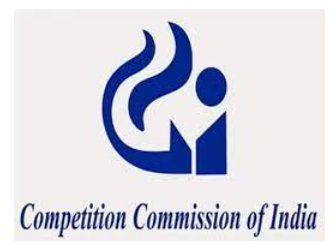
Indian Economy: A Historical Perspective
- Post-Independence Economic Model
- India initially embraced a closed economy model with import substitution and heavy government intervention.
- Paradigm Shift in the 1990s
- The early 1990s saw a shift with economic liberalisation reforms, moving towards market-oriented policies.
- Integration into Global Economy
- India adopted market-oriented policies, liberalising trade, deregulating industries, and encouraging FDI to integrate into the global economy.
- Transition to Diverse Economy
- The country shifted from a primarily agrarian economy to a dynamic one, with services and information technology gaining prominence.
India’s Current Economic Landscape
- Digital Revolution
- The Amrit Kaal brought about a digital revolution, impacting all aspects of the economy.
- Emerging Business Models
- Novel business models, particularly in the digital and tech sectors, are reshaping traditional industries.
Significance of Competition Commission of India (CCI)
- Enforcement Actions
- CCI addresses anti-competitive practices, investigating agreements and scrutinising dominant companies.
- Remedial Solutions
- CCI issues punitive and remedial solutions to rectify market distortions and restore fair competition.
- Advocacy Measures
- CCI fosters a culture of competition, educates stakeholders, and provides policy recommendations.
- Broad Mandates
- CCI’s mandates include eliminating adverse practices, promoting and sustaining competition, and consumer protection.
New-Age Challenges to CCI
- Market Concentration
- Tech giants' dominance may lead to market concentration, limiting competition.
- Stifling Innovation
- Concentration of power may stifle innovation, making it challenging for smaller competitors.
- Predatory Pricing
- Tech giants may engage in predatory pricing, posing a threat to competition.
- Exclusive Agreements
- Exclusive agreements by digital platforms can create barriers for new entrants.
CCI’s Approach to New-Age Challenges
- Global Cooperation
- CCI needs to collaborate globally to address challenges in the transnational nature of digital markets.
- Adaptation to Technology
- CCI must stay updated on technological advancements and adapt regulatory frameworks accordingly.
- Balanced Regulation
- Striking a balance between fostering innovation and implementing necessary regulations is crucial.
Conclusion
As India's economy progresses, CCI's proactive approach in identifying disruptions, leveraging technology, and fostering a competitive and innovative environment becomes pivotal for a resilient economic future. On the occasion of India's 75th independence anniversary, CCI reaffirms its commitment to shaping an economically competitive, inclusive, and resilient nation.
Source: IE
Share the article
Edukemy’s Current Affairs Quiz is published with multiple choice questions for UPSC exams
MCQ
Get Latest Updates on Offers, Event dates, and free Mentorship sessions.

Get in touch with our Expert Academic Counsellors 👋
FAQs
UPSC Daily Current Affairs focuses on learning current events on a daily basis. An aspirant needs to study regular and updated information about current events, news, and relevant topics that are important for UPSC aspirants. It covers national and international affairs, government policies, socio-economic issues, science and technology advancements, and more.
UPSC Daily Current Affairs provides aspirants with a concise and comprehensive overview of the latest happenings and developments across various fields. It helps aspirants stay updated with current affairs and provides them with valuable insights and analysis, which are essential for answering questions in the UPSC examinations. It enhances their knowledge, analytical skills, and ability to connect current affairs with the UPSC syllabus.
UPSC Daily Current Affairs covers a wide range of topics, including politics, economics, science and technology, environment, social issues, governance, international relations, and more. It offers news summaries, in-depth analyses, editorials, opinion pieces, and relevant study materials. It also provides practice questions and quizzes to help aspirants test their understanding of current affairs.
Edukemy's UPSC Daily Current Affairs can be accessed through:
- UPSC Daily Current Affairs can be accessed through Current Affairs tab at the top of the Main Page of Edukemy.
- Edukemy Mobile app: The Daily Current Affairs can also be access through Edukemy Mobile App.
- Social media: Follow Edukemy’s official social media accounts or pages that provide UPSC Daily Current Affairs updates, including Facebook, Twitter, or Telegram channels.

